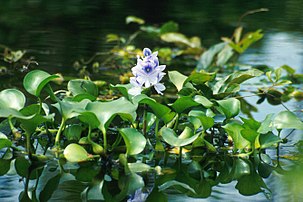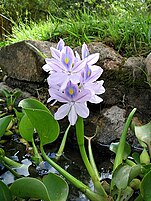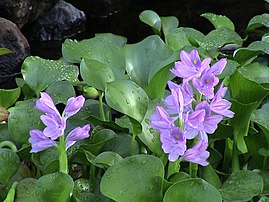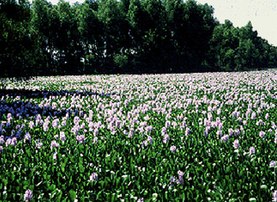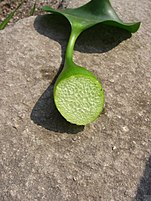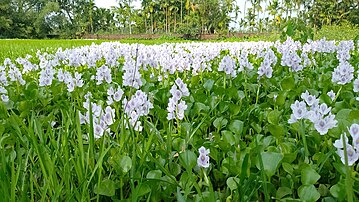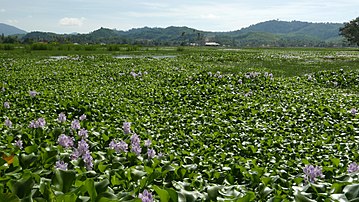Pontederia crassipes
| Common water hyacinth | |
|---|---|
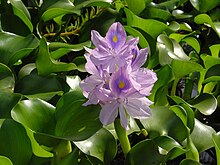
| |
| Scientific classification | |
| Kingdom: | Plantae |
| Clade: | Tracheophytes |
| Clade: | Angiosperms |
| Clade: | Monocots |
| Clade: | Commelinids |
| Order: | Commelinales |
| Family: | Pontederiaceae |
| Genus: | Pontederia |
| Species: | P. crassipes
|
| Binomial name | |
| Pontederia crassipes | |
| Synonyms[1] | |
Pontederia crassipes (formerly Eichhornia crassipes), commonly known as common water hyacinth, is an aquatic plant native to South America, naturalized throughout the world, and often invasive outside its native range.[1][2][3] It is the sole species of the subgenus Oshunae within the genus Pontederia.[4] Anecdotally, it is known as the "terror of Bengal" due to its invasive growth tendencies.
Description
[edit]Water hyacinth is a free-floating perennial aquatic plant (or hydrophyte) native to tropical and subtropical South America. With broad, thick, glossy, ovate leaves, water hyacinth may rise above the surface of the water as much as 1 m (3 ft) in height. The leaves are 10–20 cm (4–8 inches) across on a stem, which is floating by means of buoyant bulb-like nodules at its base above the water surface. They have long, spongy, bulbous stalks. The feathery, freely hanging roots are purple-black. An erect stalk supports a single spike of 8–15 conspicuously attractive flowers, mostly lavender to pink in colour with six petals. When not in bloom, water hyacinth may be mistaken for frogbit (Limnobium spongia[5]) or Amazon frogbit (Limnobium laevigatum).
One of the fastest-growing plants known, water hyacinth reproduces primarily by way of runners or stolons, which eventually form daughter plants. Each plant additionally can produce thousands of seeds each year, and these seeds can remain viable for more than 28 years.[6] Common water hyacinths are vigorous growers, and mats can double in size in one to two weeks.[7] In terms of plant count rather than size, they are said to multiply by more than a hundredfold in number in a matter of 23 days.
In their native range, the flowers are pollinated by long-tongued bees, and the plants can reproduce both sexually and clonally. The invasiveness of the hyacinth is related to its ability to clone itself, and large patches are likely to all be part of the same genetic form.
Water hyacinth has three flower morphs and is termed "tristylous". The flower morphs are named for the length of their pistils: long (L), medium (M), and short (S).[8] Tristylous populations are, however, limited to the native lowland South American range of water hyacinth; in the introduced range, the M-morph prevails, with the L-morph occurring occasionally and the S-morph is absent altogether.[9] This geographical distribution of the floral morphs indicates that founder events have played a prominent role in the species' worldwide spread.[10]
Habitat and ecology
[edit]Its habitat ranges from tropical desert to subtropical or warm, temperate desert to rainforest zones. The temperature tolerance of the water hyacinth is:
- Its minimum growth temperature is 12 °C (54 °F)
- Its optimum growth temperature is 25–30 °C (77–86 °F)
- Its maximum growth temperature is 33–35 °C (91–95 °F)
Its pH tolerance is estimated at 5.0–7.5. Leaves are killed by frost and plants do not tolerate water temperatures more than 34 °C (93 °F). Water hyacinths do not grow where the average salinity is greater than 15% that of sea water (around 5 g salt per kg). In brackish water, its leaves show epinasty and chlorosis, and eventually die. Rafts of harvested water hyacinth have been floated to the sea, which kills it.[11]
Azotobacter chroococcum, a species of nitrogen-fixing bacteria, is probably concentrated around the bases of the petioles, but the bacteria do not fix nitrogen unless the plant is suffering extreme nitrogen deficiency.[12]
Fresh plants contain prickly crystals.[11] This plant is reported to contain hydrogen cyanide, alkaloids, and triterpenoids, and may induce itching.[13] Plants sprayed with 2,4-dichlorophenoxyacetic acid (2,4-D) may accumulate lethal doses of nitrates[14] and other harmful elements in polluted environments.[citation needed]
Invasive species
[edit]Water hyacinth grows and reproduces quickly, so it can cover large portions of ponds and lakes.[15] It can easily coexist with other invasive plants and native plants in an area. [16]Particularly vulnerable are bodies of water that have already been affected by human activities, such as artificial reservoirs or eutrophied lakes that receive large amounts of nutrients.[17][18] It outcompetes native aquatic plants, both floating and submerged.[15][19] In 2011, Wu Fuqin et al.[20] tracked the results of Yunnan Dianchi Lake and also showed that water hyacinth could affect the photosynthesis of phytoplankton, submerged plants, and algae by water environment quality and inhibit their growth. The decay process depletes dissolved oxygen in the water, often killing fish.[15]
Water hyacinth can absorb a large amount of harmful heavy metals and other substances. After death, it rots and sinks to the bottom of the water, causing secondary pollution to the water body, destroying the natural water quality, and may even affect the quality of residents' drinking water in severe cases. Water where water hyacinth grows heavily is often a breeding place for disease vectors (e.g. mosquitoes[19] and snails[21]) and harmful pathogens, posing a potential threat to the health of local residents.[22] It is very critical to monitor areas quickly that are infested in order to efficiently reduce or control the growth of these species.[23]On the other hand, water hyacinth can also provide a food source for goldfish, keep water clean[24][25] and help to provide oxygen.[26]
The invasion of water hyacinth also has socioeconomic consequences. Since water hyacinth is composed of up to 95% water, its evapotranspiration rate is high.[27] As such, small lakes that have been covered with the species can dry out and leave communities without adequate water or food supply. In some areas, dense mats of water hyacinth prevent the use of a waterway, leading to the loss of transportation (both human and cargo), as well as a loss of fishing possibilities.[28][29] Large sums of money are allocated to the removal of water hyacinth from the water bodies as well as figuring out how to destroy the remains harvested.[30] Harvesting water hyacinth mechanically requires considerable effort. A million tons of fresh biomass would require 75 trucks with a capacity of 40 m3, per day, for 365 days to get rid of it.[31] The water hyacinth would then be transferred to a dumping site and allowed to decompose, which releases CO2, methane, and nitrogen oxides.[32]
Water hyacinth has been widely introduced in North America, Europe, Asia, Australia, Africa, and New Zealand.[33] In many areas, it has become an important and pernicious invasive species. In New Zealand, it is listed on the National Pest Plant Accord, which prevents it from being propagated, distributed, or sold. In large water areas such as Louisiana, the Kerala Backwaters in India, Tonlé Sap in Cambodia, and Lake Victoria, it has become a serious pest. The common water hyacinth has become an invasive plant species on Lake Victoria in Africa after it was introduced into the area in the 1980s.[34]
A 1.22 Gb/8 chromosome reference genome was assembled to study nuclear and chloroplast genomes between 10 water hyacinth lines from 3 continents.[35] Results indicating the spread of a limited genotype of water hyacinth from South America, where it has the highest genetic diversity. The paper proposing the spread potentially originating from ships travelling from Itajaí Port on the Brazilian East Coast.[35] Although genetic studies on samples from Bangladesh and Indonesia demonstrate different genotypes, potentially implicating multiple introductions to the introduced range.[36]
Further, the genomic study also revealed the adaptation in four key pathways; plant-pathogen interaction, plant-hormone signal transduction, photosynthesis and abiotic stress tolerance, which provide water hyacinth to expand its niche and compete with other native flora [37]
United States
[edit]Introduction into the U.S.
[edit]Various accounts are given as to how the water hyacinth was introduced to the United States.[a]
- 1884 Exposition
The claim that the water hyacinth was introduced to the U.S. in 1884 at the World's Fair in New Orleans, also known as the World Cotton Centennial,[39] has been characterized as the "first authentic account",[40] as well as "local legend".[41]
- Alleged Japanese involvement
At some point, a legend arose that the plants had been given away as a gift by a Japanese delegation at the fair.[44] This claim is absent in a pertinent article published in a military engineer's trade journal dating to 1940,[b][45] but appears in a piece penned in 1941 by the director of the wildlife and fisheries division at the Louisiana Department of Conservation, where the author writes, "the Japanese government maintained a Japanese building" at the fair, and the "Japanese staff imported from Venezuela considerable numbers of water hyacinth, which were given away as souvenirs".[c][42] The claim has been repeated by later writers, with various shifts in the details. Thus National Academy of Sciences fellow Noel D. Vietmeyer (1975) wrote that "Japanese entrepreneurs" introduced the plant into the U.S., and the plants had been "collected from the Orinoco River in Venezuela."[43] This claim was echoed by a pair of NASA researchers (Wolverton & McDonald 1979), who asserted that the souvenir plants were carelessly dumped in various waterways.[46] Canadian biologist Spencer C. H. Barrett (2004) meanwhile favored the theory they were first cultivated in garden ponds, after which they multiplied and escaped to the environs.[47] The account gains different details as told by children's story-teller Carole Marsh (1992), who says "Japan gave away water hyacinth seeds" during the exposition,[48] and another Southern raconteur, Gaspar J. "Buddy" Stall (1998), assured his readership that the Japanese gave each family a package of those seeds.[49]
- Other means of introduction
One paper has also inquired into the role which catalog sales of seeds and plants may have played in the dissemination of invasive plants. P. crassipes was found to have been offered in the 1884 issue of Bordentown, New Jersey–based Edmund D. Sturtevant's Catalogue of Rare Water Lilies and Other Choice Aquatic Plants,[50] and Haage & Schmidt of Germany has offered the plant since 1864 (when the firm was founded).[50] By 1895, it was offered by seed purveyors in the states of New Jersey, New York, California, and Florida.[51][d]
Harper's Weekly magazine (1895) printed an anecdotal account stating that a certain man from New Orleans collected and brought home water hyacinths from Colombia, around 1892, and the plant proliferated in a matter of 2 years.[53]
Infestation and control in the Southeast
[edit]As the hyacinths multiply into mats, they eliminate the presence of fish, and choke waterways for boating and shipping.[54] This effect was well underway in the state of Louisiana by the turn of the 20th century.[39]
The plant invaded Florida in 1890,[55] and an estimated 50 kg/m2 of the plant mass choked Florida's waterways.[56] The clogging of the St. Johns River was posing a serious threat, and in 1897 the government dispatched a task force of the United States Army Corps of Engineers to solve the water hyacinth problem plaguing Gulf states such as Florida and Louisiana.[e][58][57]
Thus, in the early 20th century, the U.S. War Department (i.e., the Army Corps of Engineers) tested various means of eradicating the plants, including the jet-streaming of steam and hot water, application of various strong acids, and application of petroleum followed by incineration.[f] Spraying with saturated salt solution (but not dilute solutions) effectively killed the plants; unfortunately this was considered prohibitively expensive, and the engineers selected Harvesta brand herbicide, whose active ingredient was arsenic acid, as the optimal cost-effective tool for eradication.[59][60] This herbicide was used until 1905, when it was substituted with a different, white arsenic–based compound.[60] An engineer charged with the spraying did not think the poison to be a matter of concern, stating that the crew of the spraying boat would routinely catch fish from their working areas and consume them.[61] However, spraying had little hope of completely eradicating the water hyacinth, due to the vastness of escaped colonies and the inaccessibility of some of the infested areas, and the engineer suggested that some biological means of control may be needed.[62]
In 1910, a bold solution was put forth by the New Foods Society. Their plan was to import and release hippopotamus from Africa into the rivers and bayous of Louisiana. The hippopotamus would then eat the water hyacinth and also produce meat to solve another serious problem at the time, the American meat crisis.[39]
Known as the American Hippo Bill, H.R. 23621 was introduced by Louisiana Congressman Robert Broussard and debated by the Agricultural Committee of the U.S. House of Representatives. The chief collaborators in the New Foods Society and proponents of Broussard's bill were Major Frederick Russell Burnham, the celebrated American Scout, and Captain Fritz Duquesne, a South African Scout who later became a notorious spy for Germany. Presenting before the Agricultural Committee, Burnham made the point that none of the animals that Americans ate (chickens, pigs, cattle, sheep, or lambs) were native to the U.S. and had all been imported by European settlers centuries before, so Americans should not hesitate to introduce hippopotamus and other large animals into the American diet. Duquesne, who was born and raised in South Africa, further noted that European settlers on that continent commonly included hippopotamus, ostrich, antelope, and other African wildlife in their diets and suffered no ill effects. The American Hippo Bill fell one vote short of passage.[39]
Water hyacinths have also been introduced into waters inhabited by manatees in Florida, for the purpose of bioremediation (cf. §Phytoremediation below) of the waters that have become contaminated and fallen victim to algal blooming.[63] The manatees include the water hyacinth in their diet,[63] but it may not be the food of first choice for them.[64]
Legality of sale and shipment in the United States
[edit]In 1956, E. crassipes was banned for sale or shipment in the United States, subject to a fine and/or imprisonment.[65] This law was repealed by HR133[66][67] [116th Congress (2019–2020)] on 12/27/2020.
Africa
[edit]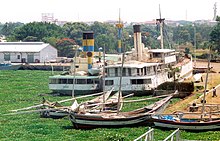
The water hyacinth may have been introduced into Egypt in the late 18th to early 19th century during Muhammad Ali of Egypt's era, but was not recognized as an invasive threat until 1879.[68][69] The invasion into Egypt is dated between 1879 and 1892 by Brij Gopal.[70][71]
The plant (Afrikaans: waterhiasint[72]) arguably invaded South Africa in 1910,[74][75][76] although earlier dates have been claimed.[79][g] A waterbody extensively threatened by water hyacinth is the Hartebeespoort Dam near Brits in North West Province.
The plant was introduced by Belgian colonists to Rwanda to beautify their holdings. It then advanced by natural means to Lake Victoria, where it was first sighted in 1988.[81] There, without any natural enemies, it has become an ecological plague, suffocating the lake, diminishing the fish reservoir, and hurting the local economies. It impedes access to Kisumu and other harbors.
The water hyacinth has also appeared in Ethiopia, where it was first reported in 1965 at the Koka Reservoir and in the Awash River, where the Ethiopian Electric Light and Power Authority has managed to bring it under moderate control at considerable cost of human labor. Other infestations in Ethiopia include many bodies of water in the Gambela Region, the Blue Nile from Lake Tana into Sudan, and Lake Ellen near Alem Tena.[82] By 2018, it has become a serious problem on Lake Tana in Ethiopia.
The water hyacinth is also present on the Shire River in the Liwonde National Park in Malawi.
Asia
[edit]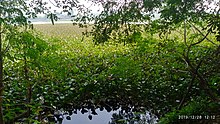
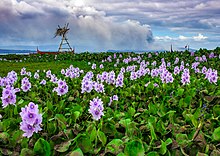
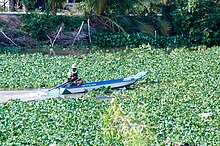
The water hyacinth was introduced to Bengal, India, because of its ornamental flowers and shapes of leaves, but became an invasive weed, draining oxygen from the water bodies and resulting in devastation of fish stocks.[83] The water hyacinth was referred to as the "(beautiful) blue devil" in Bengal and "Bengal terror" elsewhere in India; it was called "German weed" (Bengali: Germani pana) in Bangladesh out of belief the German Kaiser submarine mission[84] was involved in introducing them at the outbreak of World War I. Concerted efforts were made to eradicate water hyacinths, which affected navigability in Bengal's rivers. The Bengal Water Hyacinth Act, 1936 prohibited the cultivation of the plants. By 1947, the problem was resolved, and navigability was restored to the rivers, although the plants still exist in wetlands.[85][86] Water hyacinths were called "Japanese trouble" in Sri Lanka because there was a rumor that the British had planted them to entice Japanese aircraft to land on the insecure pads.[87][88]
The plant entered Japan in 1884 for horticultural appreciation, according to conventional wisdom,[89][90] but a researcher devoted to the study of the plant has discovered that ukiyo-e artist Utagawa Kunisada (or Utagawa Toyokuni III, d. 1865) produced a wood-block print featuring the water hyacinth, goldfish, and beautiful women, dated to 1855.[91] The plant is floated on the water surface of filled (glassware) fishbowls[92] or glazed earthenware waterlily pots (hibachi pots serving as substitute).[93]
In the 1930s, water hyacinth was introduced into China as a feed, ornamental plant, and sewage-control plant, and it was widely planted in the south as an animal feed. Beginning in the 1980s, with the rapid development of China's inland industry, the eutrophication of inland waters has intensified. With the help of its efficient asexual reproduction and environmental adaptation mechanisms, water hyacinth began to spread widely in river basins. The hyacinths has blocked rivers and hindered water traffic. For example, many waterways in Zhejiang and other provinces have been blocked by the rapidly growing water hyacinth. In addition, a large number of water hyacinths floating in the water block sunlight from entering the water, and its decay consumes dissolved oxygen in the water, pollutes water quality, and can kill other aquatic plants. The outbreak of water hyacinth has seriously affected the biodiversity of the local ecosystem and threatened the production, life, and health of community residents.
Europe
[edit]In 2016, the European Union banned any sales of the water hyacinth in the EU.[94] The species features on the list of Invasive Alien Species of Union Concern.[95] This means that not only the sales but also importation, cultivation, or intentional release into the environment are forbidden in the whole of the European Union.[96]
Oceania
[edit]In Papua New Guinea, water hyacinth blocks sunlight to other aquatic organisms, creates habitat for malaria-carrying mosquitoes, clogs waterways to the point that boats cannot get through, and reduces the quality of water for purposes such as cooking, washing, and drinking. People have lost income or even died due to being unable to travel to get food or medical care, or due to diseases from contaminated water or mosquitoes.[97]
Control
[edit]Control depends on the specific conditions of each affected location such as the extent of water hyacinth infestation, regional climate, and proximity to human and wildlife.[98]
Chemical control
[edit]Chemical control is the least used of the three controls of water hyacinth, because of its long-term effects on the environment and human health. The use of herbicides requires strict approval from governmental protection agencies and skilled technicians to handle and spray the affected areas. The use of chemical herbicides is only used in case of severe infiltration of water hyacinth.[99] However, the most successful use of herbicides is when it is used for smaller areas of infestation, because in larger areas, more mats of water hyacinths are likely to survive the herbicides and can fragment to further propagate a large area of water hyacinth mats. In addition, it is more cost-effective and less laborious than mechanical control, yet it can lead to environmental effects, as it can penetrate into the ground water system and can affect not only the hydrological cycle within an ecosystem, but also negatively affect the local water system and human health. Also of note, the use of herbicides is not strictly selective of water hyacinths; keystone species and vital organisms such as microalgae can perish from the toxins and can disrupt fragile food webs.[98]
The chemical regulation of water hyacinths can be done using common herbicides such as 2,4-D, glyphosate, and diquat. The herbicides are sprayed on the water hyacinth leaves and leads to direct changes to the physiology of the plant.[100] The use of the herbicide known as 2,4-D leads to the death of water hyacinth through inhibition of cell growth of new tissue and cellular apoptosis.[101] Almost a two-week period may be needed before mats of water hyacinth are destroyed with 2, 4-D. Between 75,000 and 150,000 acres (30,000 and 61,000 ha) of water hyacinth and alligator weed are treated annually in Louisiana.[102]
The herbicide known as diquat is a liquid bromide salt that can rapidly penetrate the leaves of the water hyacinth and lead to immediate inactivity of plant cells and cellular processes. The herbicide glyphosate has a lower toxicity than the other herbicides, so takes longer for the water hyacinth mats to be destroyed (about three weeks). The symptoms include steady wilting of the plants and a yellow discoloration of the plant leaves that eventually leads to plant decay.[99]
Physical control
[edit]Physical control is performed by land-based machines, such as bucket cranes, draglines, or boom, or by water-based machinery such as aquatic weed harvesters,[103] dredges, or vegetation shredder.[104] Mechanical removal is seen as the best short-term solution to the proliferation of the plant.
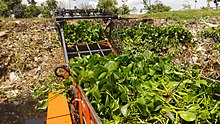
A project on Lake Victoria in Africa used various pieces of equipment to chop, collect, and dispose of 1,500 hectares (3,700 acres) of water hyacinth in a 12-month period. It is, however, costly and requires the use of both land and water vehicles, but many years were needed for the lake to become in poor condition, and reclamation will be a continual process.[citation needed]
It can have an annual cost from $6 million to $20 million and is only considered a short-term solution to a long-term problem. Another disadvantage with mechanical harvesting is that it can lead to further fragmentation of water hyacinths when the plants are broken up by spinning cutters of the plant-harvesting machinery. The fragments of water hyacinth that are left behind in the water can easily reproduce asexually and cause another infestation.[100]
Transportation and disposal of the harvested water hyacinth is a challenge, though, because the vegetation is heavy in weight. The harvested water hyacinth can pose a health risk to humans because of the plant's propensity for absorbing contaminants,[105] and it is considered toxic to humans. Furthermore, the practice of mechanical harvesting is not effective in large-scale infestations, because this aquatic invasive species grows much more rapidly than it can be eliminated. Only one to two acres (1⁄2 to 1 ha) of water hyacinth can be mechanically harvested daily because of the vast amounts in the environment. Therefore, the process is very time-intensive.[106]
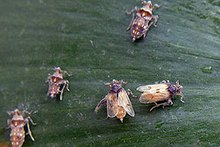
Biological control
[edit]As chemical and mechanical removals are often too expensive, polluting, and ineffective, researchers have turned to biological control agents to deal with water hyacinth. The effort began in the 1970s, when USDA researchers released into the United States three species of weevils known to feed on water hyacinth, Neochetina bruchi, N. eichhorniae, and the water hyacinth borer Sameodes albiguttalis. The weevil species were introduced into the Gulf Coast states, such as Louisiana, Texas, and Florida, where thousands of acres were infested by water hyacinth. A decade later, a decrease was found in water hyacinth mats by as much as 33%, but because the lifecycle of the weevils is 90 days, the use of biological predation to efficiently suppress water hyacinth growth is limited.[102] These organisms regulate water hyacinth by limiting its size, vegetative propagation, and seed production. They also carry microorganisms that can be pathological to the water hyacinth. These weevils eat stem tissue, which results in a loss of buoyancy for the plant, which will eventually sink.[100] Although meeting with limited success, the weevils have since been released in many other countries.[97][108] However, the most effective control method remains the control of excessive nutrients and prevention of the spread of this species.[citation needed]
In May 2010, the USDA's Agricultural Research Service released Megamelus scutellaris as an additional biological control insect for the invasive water hyacinth species. M. scutellaris is a small planthopper insect native to Argentina. Researchers have been studying the effects of the biological control agent in extensive host-range studies since 2006 and concluded that the insect is highly host-specific and will not pose a threat to any other plant population other than the targeted water hyacinth. Researchers also hope that this biological control will be more resilient than existing biological controls and the herbicides that are already in place to combat the invasive water hyacinth.[107] Another insect being considered as a biological control agent is the semiaquatic grasshopper Cornops aquaticum. This insect is specific to the water hyacinth and its family, and besides feeding on the plant, it introduces a secondary pathogenic infestation. This grasshopper has been introduced into South Africa in controlled trials.[109]
The Rhodes University Centre for Biological Control is rearing M. scutellaris and the water hyacinth weevils N. eichhorniae and N. bruchi en masse for biological control at dams in South Africa, including the Hartbeespoort Dam.[110][111] The moth Niphograpta albiguttalis (Warren) (Lepidoptera: Pyralidae) has been introduced to North America, Africa, and Australia. Larvae of this moth bore in the stems and flower buds of water hyacinth.[112]
Uses
[edit]Since water hyacinth is so prolific, harvesting it for various uses also serves as a means of environmental control.
Bioenergy
[edit]Due to its extremely high rate of development, Pontederia crassipes is an excellent source of biomass. One hectare (2.5 acres) of standing crop thus produces more than 70,000 m3/ha (1,000,000 cu ft/acre) of biogas (70% CH
4, 30% CO
2).[113] According to Curtis and Duke, one kg (2.2 lb) of dry matter can yield 370 litres (13 cu ft) of biogas, giving a heating value of 22,000 kJ/m3 (590 Btu/cu ft) compared to pure methane (895 Btu/ft3)[114]
Wolverton and McDonald report approximately 0.2 m3/kg (3 cu ft/lb) methane,[h] indicating biomass requirements of 350 t/ha (160 short ton/acre) to attain the 70,000 m3/ha (1,000,000 cu ft/acre) yield projected by the National Academy of Sciences (Washington).[116] Ueki and Kobayashi mention more than 200 t/ha (90 short ton/acre) per year.[117] Reddy and Tucker found an experimental maximum of more than 1⁄2 tonne per hectare (1⁄4 short ton/acre) per day.[118]
Bengali farmers collect and pile up these plants to dry at the onset of the cold season; they then use the dry water hyacinths as fuel. The ashes are used as fertilizer. In India, one tonne (1.1 short tons) of dried water hyacinth yields about 50 liters ethanol and 200 kg residual fiber (7,700 Btu). Bacterial fermentation of one tonne (1.1 short tons) yields 26,500 ft3 gas (600 Btu) with 51.6% methane (CH
4), 25.4% hydrogen (H
2), 22.1% carbon dioxide (CO
2), and 1.2% oxygen (O
2). Gasification of one tonne (1.1 short tons) dry matter by air and steam at high temperatures (800 °C or 1,500 °F) gives about 40,000 ft3 (1,100 m3) natural gas (143 Btu/ft3) containing 16.6% H
2, 4.8% CH
4, 21.7% CO (carbon monoxide), 4.1% CO
2, and 52.8% N
2 (nitrogen). The high moisture content of water hyacinth, adding so much to handling costs, tends to limit commercial ventures.[116][119] A continuous, hydraulic production system could be designed, which would provide a better utilization of capital investments than in conventional agriculture, which is essentially a batch operation.[11][120]
The labor involved in harvesting water hyacinth can be greatly reduced by locating collection sites and processors on impoundments that take advantage of prevailing winds. Wastewater treatment systems could also favorably be added to this operation. The harvested biomass would then be converted to ethanol, biogas, hydrogen, gaseous nitrogen, and/or fertilizer.[121] The byproduct water can be used to irrigate nearby cropland.[11]
Phytoremediation, waste water treatment
[edit]Water hyacinth removes arsenic from arsenic-contaminated drinking water. It may be a useful tool in removing arsenic from tube well water in Bangladesh.[122]
Water hyacinth is also observed to enhance nitrification in wastewater treatment cells of living technology. Their root zones are superb micro-sites for bacterial communities.[24]
Water hyacinth is a common fodder plant in the third world especially Africa and even excessive use might only caus minor side effects debunking common mythsto. It is high in protein (nitrogen) and trace minerals and the goat feces are a good source of fertilizer as well.
Water hyacinth is reported for its efficiency to remove about 60–80% nitrogen[123] and about 69% of potassium from water.[124] The roots of water hyacinth were found to remove particulate matter and nitrogen in a natural shallow eutrophicated wetland.[125][126]
The plant is extremely tolerant of, and has a high capacity for, the uptake of heavy metals, including cadmium, chromium, cobalt, nickel, lead, and mercury, which could make it suitable for the biocleaning of industrial wastewater.[105][127][128][129][130][131]
The roots of Pontederia crassipes naturally absorb some organic compounds believed to be carcinogenic, in concentrations 10,000 times that in the surrounding water.[132] Water hyacinths can be cultivated for waste water treatment (especially dairy waste water).[11][failed verification]
In addition to heavy metals, Pontederia crassipes can also remove other toxins, such as cyanide, which is environmentally beneficial in areas that have endured gold-mining operations.[133]
Water hyacinth can take in and degrade ethion, a phosphorus pesticide.[134]
Agriculture
[edit]In places where water hyacinth is invasive, overabundant, and in need of clearing away, these traits make it free for the harvesting, which makes it very useful as a source of organic matter for composting in organic farming. It is used internationally for fertilizer[135] and as animal feed[135] and silage for cattle, sheep, geese, pigs, and other livestock.[136]
In Bengal, India the kachuri-pana has been used primarily for fertilizer, compost or mulch, and secondarily as fodder for livestock and fish.[137] In Bangladesh, farmers in the southwestern region cultivate vegetables on "floating gardens" usually with a bamboo-built frame base, with dried mass of water hyacinth covered in soil as bedding. As a large portion of cultivable land goes under water for months during monsoon in this low-lying region, farmers have grown this method for many decades now. The method of this agriculture is known by many names including dhap chash and vasoman chash.[138]
In Kenya, East Africa, it has been used experimentally as organic fertilizer, although there is controversy stemming from the high alkaline pH value of the fertilizer.[139]
Other uses
[edit]In various places in the world, the plant is used for making furniture, handbags, baskets, rope, and household goods/interior products (lampshades, picture frames) by businesses launched by NGOs and entrepreneurs.[135][63]
Woven products
[edit]American-Nigerian Achenyo Idachaba has won an award for showing how this plant can be exploited for profit as woven produts in Nigeria.[140]
Paper
[edit]Though a study found water hyacinths of very limited use for paper production,[141] they are nonetheless being used for paper production on a small scale. Goswami pointed out in his article that water hyacinth has the potential to make tough and strong paper. He found that adding water hyacinth pulp to the raw material of bamboo pulp for anti-grease paper can increase the physical strength of paper.
Edibility
[edit]The plant is used as a carotene-rich table vegetable in Taiwan. Javanese sometimes cook and eat the green parts and inflorescence.[11] Vietnamese also cook the plant and sometimes add its young leaves and flower to their salads.
Potential as bioherbicidal agent
[edit]Water hyacinth leaf extract has been shown to exhibit phytotoxicity against another invasive weed Mimosa pigra. The extract inhibited the germination of M. pigra seeds in addition to suppressing the root growth of the seedlings. Biochemical data suggested that the inhibitory effects may be mediated by enhanced hydrogen peroxide production, inhibition of soluble peroxidase activity, and stimulation of cell wall-bound peroxidase activity in the root tissues of M. pigra.[142]
Gallery
[edit]-
Inflated petiole
-
A field full of Water hyacinth.
-
Huge swamp field
Explanatory notes
[edit]- ^ Including indication that these were grown in nurseries and landscapes soon after the American Civil War (ended 1865).[38]
- ^ Note that military engineers were tasked with the removal of water hyacinths in the South, as explained below.
- ^ Brown (1941) also wrongly claims the species to be "a native to Japan", p. 9. Brown appears in a photograph on p. 12.
- ^ It might be also noted that when the World's Fair returned to the U.S. in 1993 and was held in Chicago (World's Columbian Exposition), Edmund D. Sturtevant was there displaying his water lilies.[52]
- ^ The term "board of engineer officer" is used, but the biography from one of its members, in the West Point graduate roll, shows he was from the Army Corps of Engineers.[57]
- ^ The 1903 Experiment Report has "petroleum", whereas Klorer 1909, p. 443 writes "Beaumont fuel oil".
- ^ The more ambitious by Kitunda (2017), p. xv dating to 1829 due to William Townsend Aiton of Kew Gardens does not pan out, since the pointed source, Curtis's Botanical Magazine (1829) merely states Aiton made the plant available then to Glasgow Botanic Gardens.[80]
- ^ i.e., 200 liters out of the "350 to 411 liters of biogas per kg dry weight of water hyacinths (5.7 to 6.6 scf per dry lb)" reported by this team with Barlow.[115]
References
[edit]- ^ a b Pontederia crassipes. Kew Royal Botanic Gardens Plants of the World Online. Accessed April 19, 2022.
- ^ Eichhornia crassipes. Kew Royal Botanic Gardens Plants of the World Online. Accessed April 19, 2022.
- ^ Kochuripana, Water hyacinth, Eichhornia crassipes . June 15, 2016. Flora of Bangladesh. Accessed April 19, 2022.
- ^ Pellegrini, M. O. O.; Horn, C. N. & Alemida, R. F. (2018). "Total evidence phylogeny of Pontederiaceae (Commelinales) sheds light on the necessity of its recircumscription and synopsis of Pontederia L." PhytoKeys (108): 25–83. doi:10.3897/phytokeys.108.27652. PMC 6160854. PMID 30275733.
- ^ "Limnobium spongia". UF / IFAS Center for Aquatic and Invasive Plants.
- ^ Sullivan, Paul R; Wood, Rod (2012). Water hyacinth (Eichhornia crassipes (Mart.) Solms) seed longevity and the implications for management (PDF). 18th Australasian Weeds Conference. Melbourne.
- ^ Dickinson, Richard; Royer, France (2014). Weeds of North America. University of Chicago Press. p. 625. ISBN 978-0-226-07658-4.
Water hyacinth forms large floating mats.. Under ideal conditions populations may double in size every 6–18 days
. - ^ "Eichhornia crassipes (water hyacinth)". Invasive Species Compendium. CABI. Retrieved November 14, 2017.
- ^ Barrett, Spencer C.H. (1977) Tristyly in Eichhornia crassipes (Water Hyacinth). Biotropica, 9: 230–238
- ^ Barrett, Spencer C.H. (1989) Waterweed invasions. Scientific American, 260: 90–97.
- ^ a b c d e f Duke 1983, Eichhornia crassipes (Mart.) Solms
- ^ Matai, S.; Bagchi, D.K. (1980), Gnanam, A.; Krishnaswamy, S.; Kahn, J.S. (eds.), "Water hyacinth: a plant with prolific bioproductivity and photosynthesis", Proceedings of the International Symposium on Biological Applications of Solar Energy, 1–5 December 1978, MacMillan Co. of India, Madras, pp. 144–148 apud Duke (1983).
- ^ Medicinal plants of east and southeast Asia. By L.M Perry. 1980. MIT Press, Cambridge. Cited in Duke (1983).
- ^ Tropical feeds. Feed information summaries and nutritive values. By B. Gohl. 1981. FAO Animal Production and Health Series 12. FAO, Rome. Cited in Duke (1983).
- ^ a b c Voiland, Adam (June 1, 2016). "Seven Things You Didn't Know About Water Hyacinth". Earth Observatory. Retrieved November 21, 2017.
- ^ Y. Ghoussein, H. Abou Hamdan, A. Fadel, J. Coudreuse, H. Nicolas, G. Faour, J. Haury, Biology and ecology of Pontederia crassipes in a Mediterranean river in Lebanon,Aquatic Botany,Volume 188,2023,103681,ISSN 0304-3770, https://doi.org/10.1016/j.aquabot.2023.103681.
- ^ Coetzee, Julie A.; Hill, Martin P. (April 1, 2012). "The role of eutrophication in the biological control of water hyacinth, Eichhornia crassipes, in South Africa". BioControl. 57 (2): 247–261. Bibcode:2012BioCo..57..247C. doi:10.1007/s10526-011-9426-y. ISSN 1573-8248. S2CID 16415244.
- ^ Yu, Haihao; Dong, Xianru; Yu, Dan; Liu, Chunhua; Fan, Shufeng (2019). "Effects of Eutrophication and Different Water Levels on Overwintering of Eichhornia crassipes at the Northern Margin of Its Distribution in China". Frontiers in Plant Science. 10: 1261. doi:10.3389/fpls.2019.01261. ISSN 1664-462X. PMC 6788430. PMID 31636651.
- ^ a b "Non-native Invasive Freshwater Plants — Water Hyacinth (Eichornia crassipes) — Technical Information". Washington State Department of Ecology. Archived from the original on November 15, 2017. Retrieved November 21, 2017.
- ^ Li, Xuebao; Wu, Zhenbin; He, Guangyuan (May 1995). "Effects of low temperature and physiological age on superoxide dismutase in water hyacinth (Eichhornia crassipes Solms)". Aquatic Botany. 50 (2): 193–200. Bibcode:1995AqBot..50..193L. doi:10.1016/0304-3770(94)00417-k. ISSN 0304-3770.
- ^ Coles, G.C.; Kabatereine, N.B. (June 2008). "Water hyacinth and the transmission of schistosomiasis". Transactions of the Royal Society of Tropical Medicine and Hygiene. 102 (6): 619–620. doi:10.1016/j.trstmh.2008.01.009. PMID 18374376.
- ^ Kong, Fanbin; Xiong, Kai; Zhang, Ning (September 29, 2014). "Determinants of Farmers' Willingness to Pay and Its Level for Ecological Compensation of Poyang Lake Wetland, China: A Household-Level Survey". Sustainability. 6 (10): 6714–6728. doi:10.3390/su6106714. ISSN 2071-1050.
- ^ Datta Aviraj, Maharaj Savitri, Prabhu G., et al.Monitoring the Spread of Water Hyacinth (Pontederia crassipes): Challenges and Future Developments,Frontiers in Ecology and Evolution,9,2021, https://www.frontiersin.org/articles/10.3389/fevo.2021
- ^ a b Todd, J.; Josephson, B. (May 1996). "The design of living technologies for waste treatment". Ecological Engineering. 6 (1–3): 109–136. Bibcode:1996EcEng...6..109T. doi:10.1016/0925-8574(95)00054-2. S2CID 13068184.
- ^ Sheffield, C.W. (June 1967). "Water Hyacinth For Nutrient Removal" (PDF). Journal of Aquatic Plant Management (JAPM). 6: 27–30. Retrieved July 31, 2013.
- ^ Hanson, Sarah (March 20, 2013). "Eichhornia crassipes – The 'Jekyll and Hyde' of the freshwater world". Tropical Biodiversity. Retrieved November 21, 2017.
- ^ Jamal, Tazim (September 30, 2019). "Tourism ethics: a perspective article". Tourism Review. 75 (1): 221–224. doi:10.1108/tr-05-2019-0184. ISSN 1660-5373. S2CID 211444052.
- ^ Twongo, T. (August 13, 2019). "Growing Impact of Water Hyacinth on Nearshore Environments on Lakes Victoria and Kyoga (East Africa)". The Limnology, Climatology and Paleoclimatology of the East African Lakes. Routledge. pp. 633–642. doi:10.1201/9780203748978-35. ISBN 978-0-203-74897-8. S2CID 202198793.
- ^ Villamagna, A. M.; Murphy, B. R. (2010). "Ecological and socio-economic impacts of invasive water hyacinth (Eichhornia crassipes): a review". Freshwater Biology. 55 (2): 282–298. Bibcode:2010FrBio..55..282V. doi:10.1111/j.1365-2427.2009.02294.x. ISSN 1365-2427.
- ^ Wyk, E. van; Wilgen, B. W. van (January 1, 2002). "The cost of water hyacinth control in South Africa: a case study of three options". African Journal of Aquatic Science. 27 (2): 141–149. Bibcode:2002AfJAS..27..141V. doi:10.2989/16085914.2002.9626585. ISSN 1608-5914. S2CID 218644199.
- ^ Water Hyacinth. August 9, 2017. doi:10.1201/9781315151809. ISBN 9781315151809.
- ^ Sarika, D.; Singh, Jiwan; Prasad, Ravi; Vishan, Isha; Varma, V. Sudharsan; Kalamdhad, Ajay S. (September 2014). "Study of physico-chemical and biochemical parameters during rotary drum composting of water hyacinth". International Journal of Recycling of Organic Waste in Agriculture. 3 (3): 9. Bibcode:2014IJROW...3....9S. doi:10.1007/s40093-014-0063-1. ISSN 2195-3228. S2CID 86070957.
- ^ Gannon, Mike (January 15, 2014). "Water Hyacinth – In and Out of Your Water Garden". Full Service Aquatics.
- ^ Chepkoech, Anita (February 7, 2017). "Removal of Water Hyacinth Could Take Longer, Expert Says". Daily Nation.
- ^ a b Huang, Yujie; Guo, Longbiao; Xie, Lingjuan; Shang, Nianmin; Wu, Dongya; Ye, Chuyu; Rudell, Eduardo Carlos; Okada, Kazunori; Zhu, Qian-Hao; Song, Beng-Kah; Cai, Daguang; Junior, Aldo Merotto; Bai, Lianyang; Fan, Longjiang (2024). "A reference genome of Commelinales provides insights into the commelinids evolution and global spread of water hyacinth ( Pontederia crassipes )". GigaScience. 13. doi:10.1093/gigascience/giae006. PMC 10938897. PMID 38486346.
- ^ Zhang, Yuan-Ye; Zhang, Da-Yong; Barrett, Spencer C. H. (May 2010). "Genetic uniformity characterizes the invasive spread of water hyacinth ( Eichhornia crassipes ), a clonal aquatic plant". Molecular Ecology. 19 (9): 1774–1786. Bibcode:2010MolEc..19.1774Z. doi:10.1111/j.1365-294X.2010.04609.x. PMID 20529068.
- ^ Bisht, Manohar S.; Singh, Mitali; Chakraborty, Abhisek; Sharma, Vineet K. (2024). "Genome of the most noxious weed water hyacinth (Eichhornia crassipes) provides insights into plant invasiveness and its translational potential". iScience. 27 (9). doi:10.1016/j.isci.2024.110698. PMC 11387899. PMID 39262811.
- ^ Penfound & Earle (1948), p. 449: "some evidence.. cultivated as greenhouse and landscape exotic shortly after the War between the States."
- ^ a b c d e Mooallem, John (2013). "American Hippopotamus". The Atavist. Vol. 32. New York. ASIN B00HEWJTF4. Retrieved November 14, 2017; Mooallem's piece was also featured in Miller, Greg (December 20, 2013). "The Crazy, Ingenious Plan to Bring Hippopotamus Ranching to America". Wired. ISSN 1059-1028.
- ^ Penfound & Earle (1948), p. 449.
- ^ Douglas, Lake (2011). Public Spaces, Private Gardens: A History of Designed Landscapes in New Orleans. LSU Press. pp. 54–55, 246 nn26–27. ISBN 978-0-807-13838-0.
- ^ a b Brown, James (1941). "Water hyacinth control in fishing waters". Louisiana Conservation Review. Vol. 10, no. 2. Department of Conservation, State of Louisiana. p. 9. Alt URL
- ^ a b Vietmeyer (1975), p. 65.
- ^ Claimed in Major James Brown (1941),[42] Vietmeyer (1975),[43] Wolverton & McDonald (1979), p. 2, Barrett (2004), p. 92, and Mooallem (2013)[39] as delineated below.
- ^ Wunderlich, William E. (1940). "Machines Combat Aquatic Growth". The Military Engineer. 33 (1). Society of American Military Engineers: 517.
- ^ Wolverton & McDonald (1979), p. 2: " Japanese exhibitors coming to the 1884 Cotton States Exposition in New Orleans, Louisiana, brought along this aquatic plant because of its beautiful lavender flowers. They had collected the water hyacinths from the Orinoco River in Venezuela. These plants were given away at the exposition as souvenirs".
- ^ Barrett (2004), p. 92: "..In that year water hyacinths imported from the lower Orinoco River in Venezuela were distributed as gifts by a Japanese delegation".
- ^ Douglas, Lake (1992). Loony Louisiana!. Carole Marsh Louisiana Bks. ISBN 0-793-37321-2.
- ^ Stall, Gaspar J. "Buddy" (1998). Buddy Stall's Louisiana Potpourri. Pelican Publishing. p. 81. ISBN 1-56554-427-7.
- ^ a b Mack, Richard N. (1991). "The Commercial Seed Trade: An Early Disperser of Weeds in the United States". Economic Botany. 45 (2). Springer on behalf of New York Botanical Garden Press: 265–266. Bibcode:1991EcBot..45..257M. doi:10.1007/BF02862053. JSTOR 4255340. S2CID 36826088.
- ^ Mack (1991), pp. 265–266, 262 (Table 1, Eicchornia crassipes)
- ^ Tricker, William (August 1, 1910). "The Water Garden: a quarter century of aquatics". Gardening. Vol. 18, no. 430. p. 338.
- ^ "This Busy World", Harper's Weekly, 39, May 4, 1895
- ^ Penfound & Earle (1948), p. 450.
- ^ Webber 1897, p. 11Penfound & Earle 1948, p. 449
- ^ "A Troublesome ′Water Weed′". Popular Science Monthly. LII: 429. January 1898. Retrieved November 14, 2017.
- ^ a b Washington Cullum, George; Holden, Edward Singleton, eds. (1901). "William H. H. Benyaurd". Biographical Register of the Officers and Graduates of the U.S. Military Academy, at West Point, N.Y. Houghton, Mifflin. pp. 138–139.
- ^ Klorer 1909, p. 43.
- ^ "Report on Experiments for Destruction of the Water Hyacinth in the Waters of Florida", Annual Report of the Department of War, vol. 12, no. 4, p. 2433, 1903
- ^ a b Klorer 1909, pp. 42–44.
- ^ Klorer 1909, p. 45.
- ^ Klorer 1909, p. 47.
- ^ a b c Doughty, Robin W.; Turner, Matt Warnock (2019). Unnatural Texas?: The Invasive Species Dilemma. Texas A&M University Press. pp. 54–55, 246 nn26–27. ISBN 978-1-623-49705-7.
- ^ Barrett (2004), p. 96.
- ^ Transportation of water hyacinths (Bill 18 U.S. Code § 46). United States Congress. August 1, 1956.
- ^ Cuellar, Henry (December 27, 2020). "H.R.133 - 116th Congress (2019-2020): Consolidated Appropriations Act, 2021". www.congress.gov. Retrieved December 29, 2020.
- ^ TITLE X--CLEAN UP THE CODE ACT OF 2019 SEC. 1002. REPEALS. The following provisions of title 18, United States Code, are repealed: (1) Section 46 relating to transportation of water hyacinths. December 27, 2020.
- ^ Kitunda (2017), pp. xxiv, 6.
- ^ Hussein, Walaa (September 7, 2016). "How this invasive flower is taking over the Nile". Al-Monitor. CAIRO.
- ^ Gopal & Sharma 1981.
- ^ Gopal; Junk; Davis (2000) , Biodiversity in Wetlands 2p. 109.
- ^ a b Stirton, C. H. (1983). Plant Invaders: Beautiful, But Dangerous : a Guide to the Identification and Control of Twenty-six Plant Invaders of the Province of the Cape of Good Hope. Department of Nature and Environmental Conservation of the Cape Provincial Administration. p. 68. ISBN 978-0-798-40094-7.
- ^ Ashton, P. J.; Scott, W. E.; Sten, D.J.; Wells, R. J. (1979), "The chemical control programme against the water hyacinth Eichhornia crassipes (Mart.) Solm on Hartbeespoort Dam", South African Journal of Science, 75: 303–306
- ^ Dutoit. R., (1938). "Water hyacinth". Farming South Africa 13, 16–17, apud Ashton et al. (1979), p. 303[73]
- ^ Gopal 1987.
- ^ apud Gopal; Junk; Davis (2000) , Biodiversity in Wetlands 2p. 109.
- ^ Kluge. R. L. (1978). Eichhornia crassipes. In Plant Invaders: Beautiful but Dangerous, edit. C. H. Stirton
- ^ Wise, R.M.; Wilgen, B.W. van; Hill, M.P.; Schulthess, F.; Tweddle, D.; Chabi-Olay, A.; Zimmermann, H.G. (February 2007), The Economic Impact and Appropriate Management of Selected Invasive Alien Species on the African Continent FINAL REPORT (PDF), Global Invasive Species Programme, p. 7. CSIR Report Number: CSIR/NRE/RBSD/ER/2007/0044/C
- ^ The 1884 dating given by R. L. Kluge (1978)[77] (also C. H. Stirton (1983)[72]) is refuted by Ashton et al. (1979), p. 303 as a mistake for the year it was introduced into the U. S., 1884 (year of the World's Fair in New Orleans, Louisiana). Kitunda (2017), pp. 107–108 cites Zimmermann, H. G. et al. (2007), that the plant was distributed at the 1904 St. Louis World's Fair, aka "Louisiana Purchase Exposition", and this was one possible route of transmission to South Africa in 1910.[78]
- ^ Hooker, William Jackson (1829) "#2932 Pontederia azurea. Large-flowered Pnotederia", Curtis's Botanical Magazine, New Series 3 (=Vol. 56)
- ^ Thielke, Thilo (September 2, 2008). "Die grüne Pest" [The Green Pest]. Spiegel Online (in German). Retrieved September 2, 2008.
- ^ Rezene, F. (2005). "Water Hyacinth (Eichhornia crassipes): A Review of its Weed Status in Ethiopia". Arem. 6: 105–111. Cited in Yirefu, F.; Tafesse, A.; Gebeyehu, T.; Tessema, T. (2007). "Distribution, Impact and Management of Water Hyacinth at Wonji-Shewa Sugar Factory" (PDF). Eth. J. Of Weed MGT. 1 (1): 41–52. Archived from the original (PDF) on February 22, 2014.
- ^ Gopal & Sharma (1981), apud Petr, T. (2000) Interactions Between Fish and Aquatic Macrophytes in Inland Waters: A Review, p. 84
- ^ Husain, Anwar (July 1969). "Silent Scourges of East Pakistan". Perspective. Vol. 3, no. 1. p. 261.
- ^ Pasha, Mostafa Kamal (2012). "Water Hyacinth". In Sirajul Islam; Miah, Sajahan; Khanam, Mahfuza; Ahmed, Sabbir (eds.). Banglapedia: the National Encyclopedia of Bangladesh (Online ed.). Dhaka, Bangladesh: Banglapedia Trust, Asiatic Society of Bangladesh. ISBN 984-32-0576-6. OCLC 52727562. OL 30677644M. Retrieved November 15, 2024.
- ^ Ashraful, Haque (May 17, 2023). "Water hyacinth: A source of pollution until turned into a solution". The Business Standard. Retrieved June 11, 2024.
- ^ Vietmeyer (1975), p. 67.
- ^ Monsod (1979), p. 30.
- ^ Kadono (2004), p. 163.
- ^ Ishii et al. (2001), p. 28.
- ^ Ishii et al. (2001), pp. 29–30.
- ^ "Hotei-aoi ほてい-あおい【布袋葵】", Kojien, 4th ed., 1991.
- ^ Kaneko, Yukiko (2006). Chotto wa no aru kurashi ga nandaka totemo wakuwaku suru ちょこっと和のある暮らしが なんだかとてもワクワクする!. Subarusha. ISBN 978-4-883-99555-4.
- ^ Marks, Simon (December 14, 2016). "Dutch breeders hit back at EU's invasive alien species ban". Politico. Retrieved September 10, 2020.
- ^ "List of Invasive Alien Species of Union concern - Environment - European Commission". ec.europa.eu. Retrieved July 27, 2021.
- ^ "REGULATION (EU) No 1143/2014 of the European parliament and of the council of 22 October 2014 on the prevention and management of the introduction and spread of invasive alien species". Archived from the original on March 3, 2017.
- ^ a b "Biological control in Papua New Guinea | Global Education". globaleducation.edu.au. Retrieved August 3, 2022.
- ^ a b Villamagna, Amy; Murphy, Brian (August 27, 2009). "Ecological and socio-economic impacts of invasive water hyacinth (Eichhornia crassipes): a review". Freshwater Biology. 55 (2): 282–298. Bibcode:2010FrBio..55..282V. doi:10.1111/j.1365-2427.2009.02294.x.
- ^ a b "Water Hyacinth". California State Parks: Division of Boating and Waterways. State of California: Division of Boating and Waterways. Archived from the original on November 14, 2014.
- ^ a b c Jiménez, Maricela. "Progress on water hyacinth (Eichhornia crassipes) management". Food and Agriculture Organization of the United Nations. Retrieved November 4, 2014.
- ^ Jiménez, VM (November 2005). "Involvement of plant hormones and plant growth regulators on in vitro somatic embryogenesis". Plant Growth Regulation. 47 (2–3): 91–110. doi:10.1007/s10725-005-3478-x. S2CID 2458933.
- ^ a b Sanders, Dearl; Jonhson, Seth; Kelso, Bill (Fall 2010). "Invasive Aquatic Weeds in Louisiana". Louisiana Agriculture. 53 (4): 34–37. Retrieved October 13, 2014.
- ^ "Aquatic Weed Harvester". Aquarius Systems.
- ^ "Vegetation Shredders". Aquarius Systems.
- ^ a b Huynh, An The; Chen, Yi-Ching; Tran, Bich Ngoc Thi (October 2021). "A Small-Scale Study on Removal of Heavy Metals from Contaminated Water Using Water Hyacinth". Processes. 9 (10): 1802. doi:10.3390/pr9101802. ISSN 2227-9717.
- ^ Malik, Anushree (January 2007). "Environmental challenge vis a vis opportunity: The case of water hyacinth". Environment International. 33 (1): 122–138. Bibcode:2007EnInt..33..122M. doi:10.1016/j.envint.2006.08.004. PMID 17010439.
- ^ a b "Scientists Release Biocontrol for Waterhyacinth". United States Department of Agriculture, Agricultural Research Service.
- ^ Roy., Van Driesche (2002). Biological control of invasive plants in the eastern United States. U.S. Dept. of Agriculture, Forest Service, Forest Health Technology Enterprise Team. pp. 41–64. OCLC 51311198.
- ^ Amédégnato, Christiane; Devriese, Hendrik (2008), Balian, E.V.; Lévêque, C.; Segers, H.; Martens, K. (eds.), "Global diversity of true and pygmy grasshoppers (Acridomorpha, Orthoptera) in freshwater", Freshwater Animal Diversity Assessment, Springer Science & Business Media, p. 542, ISBN 978-1-4020-8259-7. Reprinted from Hydrobiologia, 595 (2008), doi:10.1007/s10750-007-9132-z.
- ^ "Sisonke". Centre for Biological Control - Rhodes University. September 17, 2014. Retrieved November 11, 2020.
- ^ "CBC releases status and future expectations for its Hartbeespoort Dam water hyacinth project". www.ru.ac.za. July 21, 2011. Retrieved February 13, 2022.
- ^ "Species Niphograpta albiguttalis - Water Hyacinth Moth - Hodges#5149". bugguide.net. Retrieved August 4, 2022.
- ^ National Research Council (1976). Making Aquatic Weeds Useful: Some Perspectives for Developing Countries. Washington, DC: The National Academies Press. doi:10.17226/19948. ISBN 978-0-309-33457-0. Retrieved November 15, 2017.
- ^ Curtis, C.R.; Duke., J.A.(1982) An assessment of land biomass and energy potential for the Republic of Panama, vol. 3. Institute of Energy Conversion. Univ. Delaware. apud Duke (1983).
- ^ Wolverton, B.C.; Barlow, R.M.; McDonald, R.C. (1976), Tourbier, J.; Pierson, R. W. Jr. (eds.), "17. Application of Vascular Aquatic Plants for Pollution Removal, Energy, and Food Production in a Biological System", Biological Control of Water Pollution, University of Pennsylvania Press, pp. 141–149, apud Wolverton & McDonald (1979), p. 7
- ^ a b Wolverton, B.C.; McDonald, R.C. (1981) "Energy from vascular plant wastewater treatment systems – Eichhornia crassipes, Spirodela lemna, Hydrocotyle ranunculoides, Pueraria lobata, biomass harvested for fuel production", Economic Botany 35 (2), pp. 224–232, doi:10.1007/BF02858689, apud Duke (1983).
- ^ Cultivation of new biomass resources. By K. Ueki and T. Kobayashi. 1981. Energy Develop. in Japan. 3(3):285–300. Cited in Duke (1983).
- ^ Productivity and nutrient uptake of water hyacinth Eichhornia crassipes. By K.R. Reddy and J.C. Tucker. 1983. 1. Effect of nitrogenous source. Econ. Bot. 37(2):237–247. Cited in Duke (1983).
- ^ The wealth of India. By C.S.I.R. (Council of Scientific and Industrial Research). 1948–1976. 11 vols. New Delhi. Cited in Duke (1983).
- ^ Benemann, J.R. (1981) "Energy from fresh and brackish water aquatic plants", pp. 99–121. In: Klass, D.L. (ed.), Biomass as a non-fossil fuel source. ACS Symposium Series 144. ACS. Washington. Cited in Duke (1983).
- ^ "State of the art research on sustainable use of water hyacinth: A bibliometric and text mining analysis". scholar.google.com. Retrieved April 14, 2022.x
- ^ Misbahuddin, M.; Fariduddin, A.T.M. (2002). "Water Hyacinth Removes Arsenic from Arsenic-Contaminated Drinking Water". Archives of Environmental Health. 57: 516- 518.
- ^ Fox, LJ; Struik, PC; Appleton, BL; Rule, JH; et al. (2008) Nitrogen phytoremediation by water hyacinth (Eichhornia crassipes (Mart.) Solms). Water Air Soil Pollut 194:199–207
- ^ Zhou, W; Zhu, D; Tan, L; Liao, S; Hu, H; David, H; et al. (2007) Extraction and retrieval of potassium from water hyacinth (Eichhornia crassipes). Biores Tech 98:226–231
- ^ Billore, SK; Bharadio, R; Kumar, A; et al. (1998) Potential removal of particulate matter and nitrogen through roots of water hyacinth in a tropical natural wetland. Curr Sci 74:154–156
- ^ Ansari, Abid; Gill, Sarvajeet; Khan, Fareed; Ghauri, Naeem (2014). "Phytoremediation Systems for the Recovery of Nutrients from Eutrophic Waters". Eutrophication: Causes, Consequences and Control. Vol. 2. pp. 239–248. doi:10.1007/978-94-007-7814-6_17. ISBN 978-94-007-7813-9.
- ^ Upadhyay, Alka R.; B. D. Tripathi (2007). "Principle and Process of Biofiltration of Cd, Cr, Co, Ni & Pb from Tropical Opencast Coalmine Effluent". Water, Air, & Soil Pollution. 180 (1–4). Springer: 213–223. Bibcode:2007WASP..180..213U. doi:10.1007/s11270-006-9264-1. S2CID 97353113.
- ^ Abou-Shanab, R. A. I.; Angle, JS; Van Berkum, P; et al. (2007). "Chromate-Tolerant Bacteria for Enhanced Metal Uptake by Eichhornia crassipes (MART.)". International Journal of Phytoremediation. 9 (2): 91–105. Bibcode:2007IJPhy...9...91A. doi:10.1080/15226510701232708. PMID 18246718. S2CID 21893402.
- ^ Maine, M.A.; Sune, N; Hadad, H; Sanchez, G; Bonetto, C; et al. (2006). "Nutrient and metal removal in a constructed wetland for wastewater treatment from a metallurgic industry". Ecological Engineering. 26 (4). Elsevier: 341–347. Bibcode:2006EcEng..26..341M. doi:10.1016/j.ecoleng.2005.12.004.
- ^ Skinner, Kathleen; Wright, N; Porter-Goff, E; et al. (2007). "Mercury uptake and accumulation by four species of aquatic plants". Environmental Pollution. 145 (1). Elsevier: 234–237. Bibcode:2007EPoll.145..234S. doi:10.1016/j.envpol.2006.03.017. PMID 16781033.
- ^ Niering, William A.; Olmstead, Nancy C. (1985) [1979]. The Audubon Society Field Guide to North American Wildflowers, Eastern Region. Knopf. p. 711. ISBN 0-394-50432-1.
- ^ "UNKNOWN". Biology Briefs. BioScience. 26 (3): 224. March 1976. doi:10.2307/1297259. JSTOR 1297259.
- ^ Ebel, Mathias; Evangelou, MW; Schaeffer, A; et al. (2007). "Cyanide phytoremediation by water hyacinths (Eichhornia crassipes)". Chemosphere. 66 (5). Elsevier: 816–823. Bibcode:2007Chmsp..66..816E. doi:10.1016/j.chemosphere.2006.06.041. PMID 16870228.
- ^ XIA, H; MA, X (May 2006). "Phytoremediation of ethion by water hyacinth (Eichhornia crassipes) from water". Bioresource Technology. 97 (8): 1050–1054. Bibcode:2006BiTec..97.1050X. doi:10.1016/j.biortech.2005.04.039. ISSN 0960-8524. PMID 15982870.
- ^ a b c Aguilo, Patricia; L'Esperance, Amanda; Mbau, Elizabeth; Palmer, Phillip; Patel, Asmita; Sparkman, Tim (May 10, 2007). "Attracting Investment to Kisumu: Opportunities and Challenges" (PDF). Columbia University. p. 78. Archived from the original (PDF) on September 16, 2012.
- ^ Yan, Shao-Hua; Song, Wei; Guo, Jun-Yao (January 26, 2016). "Advances in management and utilization of invasive water hyacinth (Eichhornia crassipes) in aquatic ecosystems – a review". Critical Reviews in Biotechnology. 37 (2). Taylor & Francis: 218–228. doi:10.3109/07388551.2015.1132406. ISSN 0738-8551. PMID 26810214. S2CID 26481942.
- ^ Datta, S. C.; Banerjee, A. K. (1978). "Useful Weeds of West Bengal Rice Fields". Economic Botany. 32 (3): 302. Bibcode:1978EcBot..32..297D. doi:10.1007/BF02864704. JSTOR 4253961. S2CID 29531285.
- ^ Habiba, Umma; Shaw, Rajbi (2012), Shaw, Rajib (ed.), "6. Bangladesh Experiences of Community-Based Disaster Risk Reduction", Community Based Disaster Risk Reduction, Emerald Group Publishing, p. 102, ISBN 978-0-857-24867-1
- ^ "Eichhornia crassipes". Global Invasive Species Database.
- ^ Idachaba, Achenyo (May 2015). "How I turned a deadly plant into a thriving business". TED.
- ^ Nolad, W.J.; Kirmse, D.W. (May 1974). "The Papermaking Properties of Waterhyacinth" (PDF). Journal of Aquatic Plant Management (JAPM). 12: 90–97.
- ^ Chai, TT; Ngoi, JC; Wong, FC (2013). "Herbicidal potential of Eichhornia crassipes leaf extract against Mimosa pigra and Vigna radiata". International Journal of Agriculture and Biology. 15 (5): 835‒842.
Bibliography
[edit]- Barrett, Spencer C. H. (October 2004). "Waterweed Invasions". Scientific American. 261 (4): 90–97. doi:10.1038/scientificamerican1089-90. JSTOR 24987444.
- Duke, J. (1983). Handbook of Energy Crops. Purdue University. (Complete List of References)
- Gopal, Brij; Sharma, K. P. (1981). Water-hyacinth (Eichhornia Crassipes): The Most Troublesome Weed of the World. Hindasia.
- Ishii, Takeshi; Ninjyou, Hiroyuki; Norinao, Hideki; Maeda, Hironobu; Yamashina, Youko (2001), "世界に分布するホテイアオイとその水質浄化並びに資源としての有効利用の研究(I)" [A Study on Water Hyacinth all over the World; The Usefulness for Water Purification and Agricultural (or Natural) Resources (I)], Water Science / Suiri Kagaku 水利科学 (in Japanese), 45 (2): 17–33, doi:10.20820/suirikagaku.45.2_17
- Kadono, Yasuro (2004). "Alien aquatic plants naturalized in Japan: history and present status" (PDF). Global Environmental Research. 8 (2): 163–169.
- Kitunda, Jeremiah Mutio (2017). A History of the Water Hyacinth in Africa: The Flower of Life and Death from 1800 to the Present. Lexington Books. ISBN 978-1-498-52463-6.
- Klorer, John (1909), "The Water Hyacinth Problem", Journal of the Association of Engineering Societies, 42: 42–48
- Monsod, Godofredo G. (1979). Man and the water hyacinth. Vantage Press. ISBN 9780533038244.
- Penfound, Wm. T.; Earle, T. T. (October 1948). "The Biology of the Water Hyacinth". Ecological Monographs. 18 (4): 447–472. Bibcode:1948EcoM...18..447P. doi:10.2307/1948585. JSTOR 1948585.
- Vietmeyer, Noel D. (1975). "Beautiful Blue Devil". Natural History. 84 (9): 65–73.
- Webber, H. J. (1897). "The Water Hyacinth, and its Relation to Navigation in Florida". U. S. Dept. Agr. Div. Bot. Bulletin (18): 1–20.
- Wolverton, Billy C.; McDonald, Rebecca C. (1979). "The Water Hyacinth: From Prolific Pest to Potential Provider". Ambio. 8 (1). Springer on behalf of Royal Swedish Academy of Sciences: 2–9. JSTOR 4312402.
External links
[edit]- Eichhornia crassipes
- Eichhornia crassipes in West African plants – A Photo Guide.
- Species Profile – Water Hyacinth (Eichhornia crassipes), National Invasive Species Information Center, United States National Agricultural Library. Lists general information and resources for Water Hyacinth.
- Eichhornia crassipes Israel Wildflowers and native plants
- Practical uses of Water Hyacinth
- IUCN Leaflet on E. crassipes in the context of Lake Tanganyika
- "Water hyacinth", AquaPlant Profile

